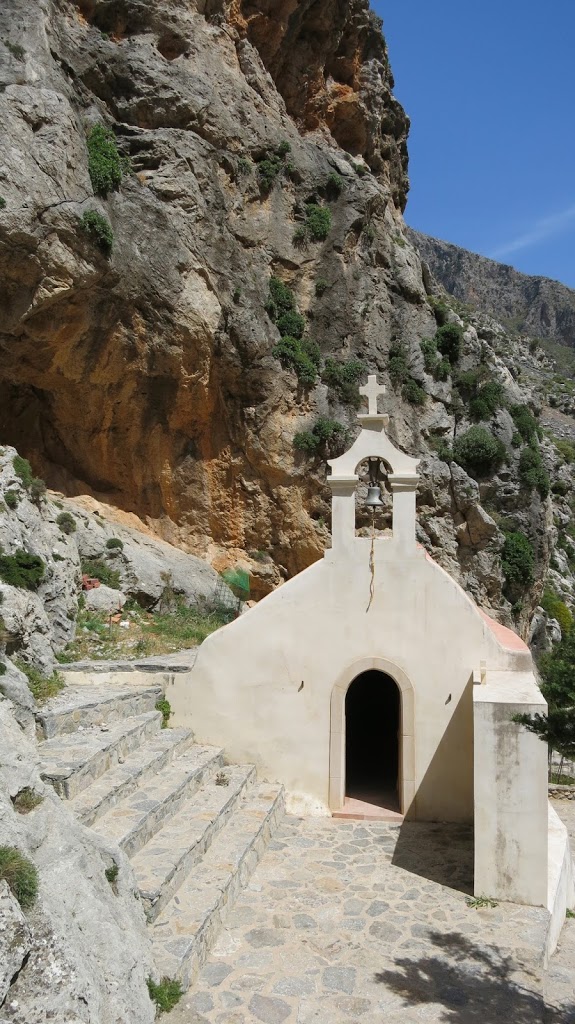
Pleasant Surprises on the Backroads of Crete
 |
| The Church of St. Nicholas in Kourtaliotis Gorge, Crete |
 |
| Piles of stones beside St. Nicholas Church |
I cherish my trips with Backroads Travel Co. To me the backroads of Crete are full of surprises, in addition to olive orchards, oleanders and orange groves. On our 3rd day we road from the north to south part of the island. On the way to the beach at Plakias, we bicycled through the Kourtaliotis Gorge. The scenery was breathtaking. A tiny church, St. Nicholas was nestled behind the oleander and the rocks. It seemed to be a place where only a handful of monks prayed a long time ago. Behind it were small piled-up shrines of stone, which resemble votive offerings beside the church.
Crete’s small country churches surprised me, but even smaller churches, or replicas of churches dot the sides of the country roads. These small shrines are all over the place.
 |
| A typical memorial erected among the orange groves of Crete |
They’re memorials to loved ones who’ve died and we saw them frequently. One of the hotshot men on our trip, Dennis, reprimanded me for taking photos of graves in churchyards. He told me, “It is bad luck.” (His mother’s family is from Crete.)
The day after we went to the Kourtaliotas Gorge, I experienced bigger surprises — a pair of surprises. Cindy (she lives in Shanghai and was also on the lookout for great photos) & I came upon an abandoned church, seemingly in the middle of nowhere. We both took pictures. Cindy biked on, but I decided to check out the inside.
 |
| A 14th century church between the villages of Koufos and Alikianos |
Through the opening of a locked door, I could see that in the center of the church was a fresco of Mary surrounded by two saints. It was too narrow to photograph, but the image was clear but had two big vertical cracks. There were more frescoes to the sides and above, but I really couldn’t see them.
On the outside of the church, a fresco of Mary adorns the pointed arch over a side door. It was badly damaged, but I took a picture (below). It also had painted trim directly under the arch in a beautiful red and blue pattern, and a Greek cross below that.
 |
| A badly damaged fresco of Mary over the door dates to the 14th century |
Paintings on the outside of a buildings can’t withstand time and weather.
The sign on the road pointed to Church of the Zoohodos Pigi (in Greek and in English, but what could that possibly mean?) (Later when I was home and looked it up on the Internet, I found a few churches of the same name in Greece.)
This church lies between Alikianos and Koufos. It was built in the early 14th century following an earthquake of 1303, but over the foundations of a 10th century church. (Earthquakes have always been a problem on this island, and in much of the Mediterranean.)
 |
| Zoohodos Pigi means “life giving source.” |
El Greco, Greece’s greatest artist in modern times, was from this part of Crete. No one knows exactly where El Greco was born, but his family was from Chania and this church is about 10-20 miles away.
We had already passed a town called Alikianos where there was large new blue and terra cotta colored Greek Orthodox church. It’s easy to understand why a church in the middle of nowhere was abandoned.
I hope that the Church of Zoohodos Pigi will be restored. Apparently it was quite an important church at one time. Zoohodos Pigi means “life-giving source.”
 |
|||
| There’s a new Greek Orthodox church in the village of Alikianos |
Just a few miles down the road, I had caught up with Cindy. We had to go up hills too steep for my endurance, and then we turned a corner and stopped. Here came the the biggest surprise of all:
It was lunch time and someone had just dumped a big truck of excess oranges in a goat pen and the goats were chomping away, peels and all. They were chomping like crazy, as if in a contests to finish first. We took many pictures.
How funny to realize that these delicious goat cheeses we’ve been eating in Crete come from animals who feed on oranges, the delicious oranges of Crete!
 |
| The Goats’ lunch — so good! |
I discovered both Greek cheeses and orange cake, also called orange pie, on this trip. My grocery store oranges aren’t quite like the oranges I had been eating, and I haven’t found Graviera cheese in any of my local markets. There’s nothing like feeling close to history, the land, the animals and the sea than in a Backroads biking trip.

Recent Comments